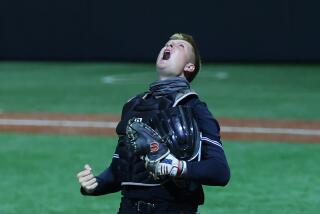Prospects Dialing for Dollars in Area Code Games : Baseball: Best of high school Class of 1994 hope to make the grade by impressing pro scouts and college coaches.
- Share via
SAN DIEGO — It doesn’t take long to realize these are no ordinary baseball games. To determine just how long, find someone with a stopwatch. And at the Area Code Games, that’s about as difficult as finding an empty seat at a San Diego Padre home game.
At the gate to San Diego State’s Smith Field, a woman hands out rosters listing the names, heights, weights, phone numbers and 60-yard dash times of the 200-plus players involved.
Inside the park, just after the crack of the bat, you hear a hundred tiny beeps coming from all directions. When the batter’s foot hits first base, there they are again.
The scouts clustered behind home plate look at their stopwatches. They look at one another.
“Four-one-eight?” one asks.
“Yep,” says another.
They scrawl numbers on their rosters. Home-to-first in 4.18 seconds, from the right-handed batter’s box. Another “prospect” discovered. That’s precisely why about 200 professional scouts and 60 college recruiters have flocked to San Diego.
The 17 Valley-area players chosen to participate will not play in front of more scouts at one time the rest of their lives. Designed specifically to showcase the best high school talent in the class of 1994, the annual Area Code Games, which conclude today, are a four-day meat market of talent.
“It’s outstanding,” says Jay Robertson, Cleveland Indians’ scouting director. “It’s a situation where you can get a read on a lot of kids coming up.”
*
The Area Code Games were born eight years ago in the mind of Bob Williams, a real estate developer from Santa Rosa. The idea was to have major league teams sponsor the event and their scouts would then choose the players.
In 1987, six California teams, grouped by telephone area codes, met in Lodi. This week, 10 teams came to San Diego, five from California, one from the Pacific Northwest, one from the Rocky Mountains, one from Hawaii and one from the rest of the country. The Australian national team, which happened to be in Southern California preparing for an international tournament, rounded out the 10-team field.
The major league sponsors outfit the players in uniforms--typically old minor league uniforms or those about to be used in instructional league--and supply wooden bats. The Angels sponsor three teams, including the one representing the 818 and 805 areas.
The point is not really to win. Far from it. Standings aren’t kept. No trophies are awarded and no champion is named. The outcomes are so irrelevant that if seven innings haven’t been played in two hours, the games just end. Such restraints are necessary to squeeze in five games a day without cutting pregame infield practice, which scouts watch more intently than the games.
Once the games begin, the scouts are busy collecting raw data: running times, catchers’ times getting the ball to second base and pitchers’ velocity. When a pitcher starts an inning, he faces about 40 radar guns.
“It gets to you a little,” said Bill Scheffels, a right-hander from Simi Valley High who started Wednesday. “They tell you to shake it off, but it gets kind of hard.”
Left-hander Randy Wolf of El Camino Real said former teammate Dan Cey, who accepted a scholarship to California and was drafted by the San Diego Padres, has been preparing him for the games for months.
“He just kept telling me, ‘You gotta do good, you gotta do good,’ ” Wolf said. “It doesn’t make me nervous. You can’t think about (all the scouts). If you do, you won’t do well.”
Pressure? Sure. But consider the payoff.
In June, 80 players were drafted from the eight teams at the games last year in San Jose, including 17 in the first four rounds. Williams said normally about half the players are drafted and nearly all others play in college.
All of the recent first-round draft picks from the Valley area--Roger Salkeld, Mike Lieberthal, Dmitri Young and Derek Wallace--are “graduates” of the Area Code Games.
Young, the fourth selection in the 1991 draft, holds a special place in Williams’ heart, though, because the former Rio Mesa High player donated $1,500 to the program as a way of saying thanks for the boost it gave his career.
Of the 19 Valley-area players who played last year, 18 were either drafted or will be playing Division I college baseball in the spring.
Newbury Park shortstop David Lamb, who slipped into the games between rounds of the American Legion playoffs last summer, emerged as one of the top high school players in the nation. Lamb was drafted in the second round by the Baltimore Orioles in June. Last month, he signed for a bonus package worth about $300,000.
Lamb was a prospect last year before he arrived in San Jose, though. Scouts insist there are few surprises at the Area Code Games.
But look at Tom Buchman, a catcher from Lenexa, Kan., who initially was not chosen to play at the games last year. Buchman phoned Williams and told him Stanford had recommended him for the games. Feeling no need to confirm that with Stanford, Williams invited Buchman.
“I could tell from the tone of his voice I could believe him,” Williams said.
Buchman played so well at the games he soon filled his schedule with five recruiting trips, the NCAA limit. He eventually signed with Texas A&M.; In June, the Kansas City Royals made him a 10th-round draft pick.
Then there’s Justin Siegel.
Siegel, a left-hander from Taft, pitched three good innings last year in San Jose. North Carolina State recruiting coordinator Storm Toman liked what he saw. Toman hasn’t seen Siegel pitch since, but North Carolina State offered Siegel a partial scholarship. By accepting, Siegel became the only player the school signed from the 1992 Area Code Games.
In addition to all the major West Coast colleges, recruiters came to San Diego from Texas A&M;, Mississippi State, Tennessee, Vanderbilt, North Carolina, Georgia Tech, Yale, Dartmouth and Georgia, to name a few.
“The big programs can fill their whole recruiting class in one place,” said Robin Dreizler, UCLA pitching coach.
Williams would like to see college coaches follow the lead of major league baseball and make a donation to the program.
“If I had a nice donation from college coaches, I’d add a column to the rosters with grade-point averages,” Williams said.
Besides the coaches and scouts, other parties take advantage of the spotlight. On every windshield in the parking lot across from Smith Field were bright yellow flyers promoting a pair of seminars entitled, “Everything you always wanted to know about the June draft . . . but were afraid to ask.”
Steve Caruso, an agent, holds the seminars, which he advertises as, “The seminar some scouts and scouting directors don’t want you to attend.” The seminars inform players of draft rules, what scouts look for and the signing process.
According to Robertson, the Indians’ scouting director, the agents’ presence is one of the reasons some teams have dropped sponsorship of the games, although he said he has no problem with the seminars.
“It makes the players more aware,” he said. “Agents and college coaches are no competition for us. We are looking for kids who want to play pro ball.”
This Talent Hasn’t Been Phony
Seventeen Valley-area baseball players are participating this week in the Area Code Games. Of the 19 who played last season, 18 were either selected in baseball’s June amateur draft or will be playing Division I college baseball.
THIS YEAR’S ROSTERS
Player Pos High School Bill Scheffels RHP Simi Valley Brad Wright 1B Crespi Darrell Dent OF Montclair Prep Dave Forst 1F Brentwood Mike Glendenning 3B Crespi Kirk Hagge SS Crescenta Valley Ryan Hankins 3B Simi Valley Rich Igou LHP Notre Dame Bryan LaCour SS Chatsworth Justin Martin OF El Camino Real Ethan Parker OF Montclair Prep Jim Parque LHP Crescenta Valley Jon Schaeffer C Harvard-Westlake Keith Smith RHP Newbury Park Carlos Velazco RHP Sylmar Randy Wolf LHP El Camino Real Joel Zamudio RHP Monroe
THE CLASS OF ’92
Player Pos Where He Is or Is Going Glen Carson 1B Will Attend USC Jeff Suppan RHP Signed with Red Sox Casey Snow C Will Attend CS Long Beach Stacy Kleiner C Will Attend UNLV Jeff Shapiro SS Will Attend Arizona Justin Paperny 2B Will Attend USC Dan Cey SS Will Attend California Ryan Stromsborg SS Will Attend USC Andy Dominique 3B Will Attend Nevada Justin Balser IF Will Attend UC Santa Barbara Mark Lopez OF Will Attend Pepperdine Brian Powers 3B Will Attend Arizona Evan Howland RHP Attending CS Northridge Chris Garza LHP Will Attend Nevada Chris Leveque LHP Will Attend Pierce College Justin Siegel LHP Will Attend N.C. State Kevin Nykoluk C Expos or Moorpark JC David Lamb SS Signed with Orioles Brad Fullmer IF Expos or Stanford
More to Read
Go beyond the scoreboard
Get the latest on L.A.'s teams in the daily Sports Report newsletter.
You may occasionally receive promotional content from the Los Angeles Times.










